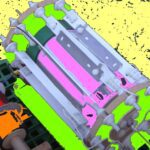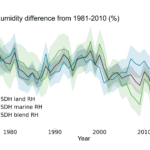Published in 1881, An Elementary Treatise on Electricity evolved from notes Maxwell had written in preparation for lectures on electricity at the Cavendish Laboratory.
In June 2023, the national media carried a story about a book 115 years overdue that was returned to the Free Public Library in New Bedford, Mass. The book turned out to be An Elementary Treatise on Electricity by James Clerk Maxwell, published in 1881.
My colleague Martin Rowe visited the library to examine and photograph that specific volume and interviewed the librarian about its history and return. I became interested in the content of the book, and because the New Bedford library no longer lets anyone check out from the building, I found a cellphone-compatible version that I could take to the beach for some summer reading.
When and why did Maxwell write this book?
It appears that Maxwell wrote most of the book in the mid-1870s for use with his lectures on electricity at the Cavendish Laboratory. The work remained incomplete on Maxwell’s death in 1879, and editors decided to add selections from his earlier work A Treatise on Electricity and Magnetism, published in 1873, to provide students with a comprehensive discussion of electrical measurements. (These additions were omitted from an 1888 edition, by which time more literature was available on the topic.)
Does the book include Maxwell’s equations?
No, although they govern the electromagnetic behaviors described. Maxwell’s versions of the famous equations are presented in “A dynamical theory of the electromagnetic field,” which Maxwell submitted to the Royal Society in 1864 and was published in the Philosophical Transactions of the Royal Society in 1865. You can download a copy here.
In fact, Maxwell at times takes care to avoid the use of equations in An Elementary Treatise on Electricity. In a chapter titled “Diagrams of Equipotential Surfaces,” he writes that “we may proceed by mathematical methods” or we may employ “the humbler method of actually drawing tentative figures on paper and selecting that which appears least unlike the figure we require.” The latter method, he writes, provides “an eye for knowledge of the forms of the equipotential surfaces [that] often leads to a right selection of a mathematical method of solution.”
He continues, “I have therefore drawn several diagrams of systems of equipotential surfaces and lines of force, so that the student may make himself familiar with the forms of the lines.” Figure 1 shows the first of these diagrams, representing two like charges A and B separated by distance AB, with A having four times the charge of B. The equilibrium point P appears at a distance AP=(2/3)AB from A. For the record, the mathematical solution would involve superposition, to which Maxwell devotes a chapter in An Elementary Treatise on Electricity, and his first equation, based on Gauss’s law for static electric fields.

What other topics does the book cover?
Topics include measurement of electromotive force, capacitance (“capacity of a condenser”), inductance, and electric current. Sections carried over from the earlier A Treatise on Electricity and Magnetism extensively cover resistance measurements.
The book also includes a chapter titled “Phenomena of an Electric Current Which Flows Through Heterogeneous Media,” which covers the Peltier and Seebeck effects. About the latter, Maxwell writes, “Seebeck, in 1822, discovered that if a circuit is formed of two different metals, and if the two junctions of the metals are kept at different temperatures, an electric current tends to flow round the circuit.” He takes care to dispel any idea that the ability to generate a current by connecting dissimilar metals could lead to a perpetual-motion machine: “In a circuit formed of any number of metals all at the same temperature, there can be no current, for if there were a current it might be constantly employed to work a machine or to generate heat in a conductor, and this without any energy being supplied to the system from without….”
Which instruments were available to Maxwell?
One instrument was the galvanometer, often used in conjunction with a Wheatstone bridge. Figure 2 shows this combination used in the “measurement of the resistance of a battery when in action….” The Wheatstone bridge remains a useful circuit configuration, as demonstrated by a webinar from HBK posted earlier this year.

What were some of the practical applications of Maxwell’s work at the time, and what specific projects did he work on?
In part 2 of this two-part article, I’ll describe the “killer app” of the late 19th century, the contributions of Maxwell and others, and the ramifications for the study of electrical engineering.
Where can I find a copy of An Elementary Treatise on Electricity that I can take to the beach?
You can browse a scan of the original book at the Internet Archive here, and Project Gutenberg offers a digitized and searchable eBook version here.
Continue to part 2.






Leave a Reply
You must be logged in to post a comment.